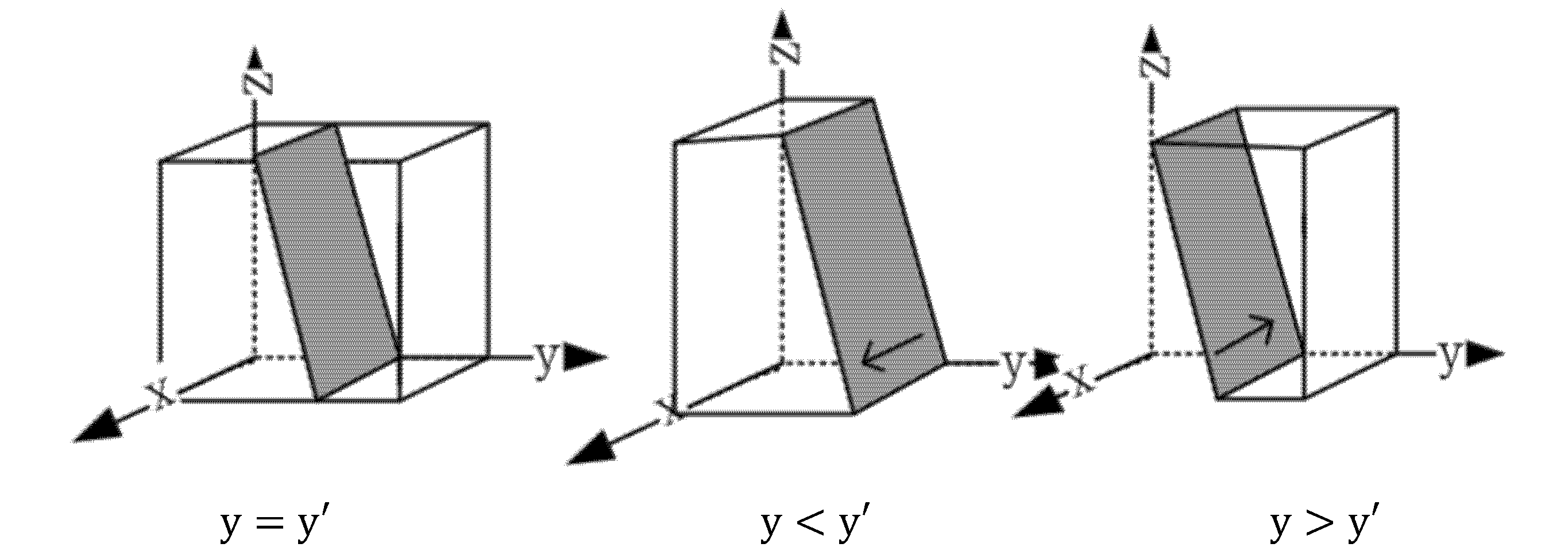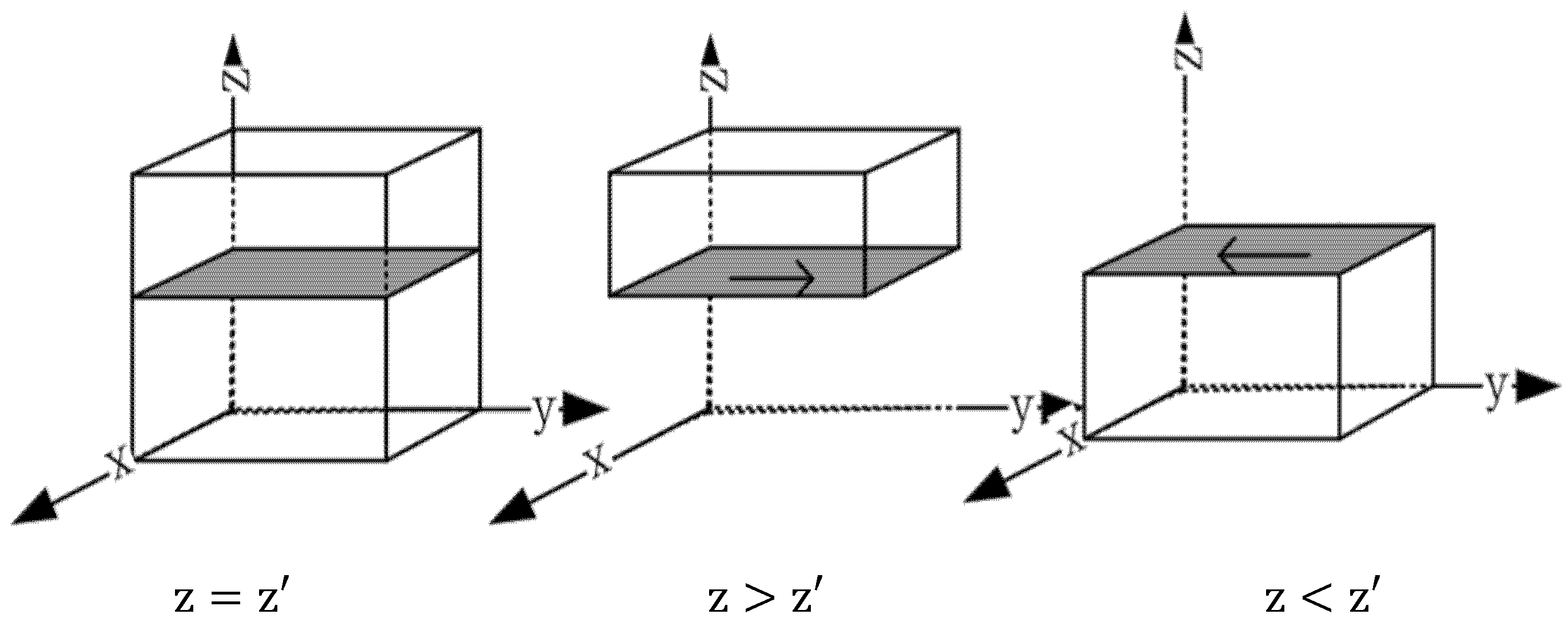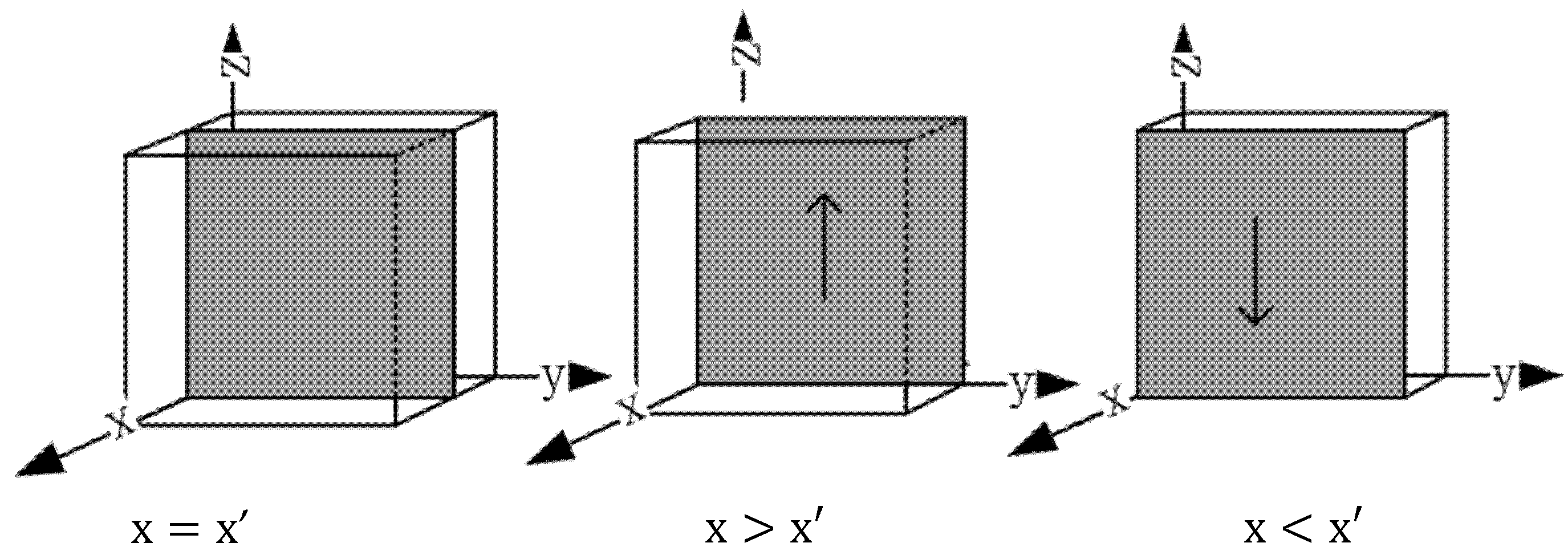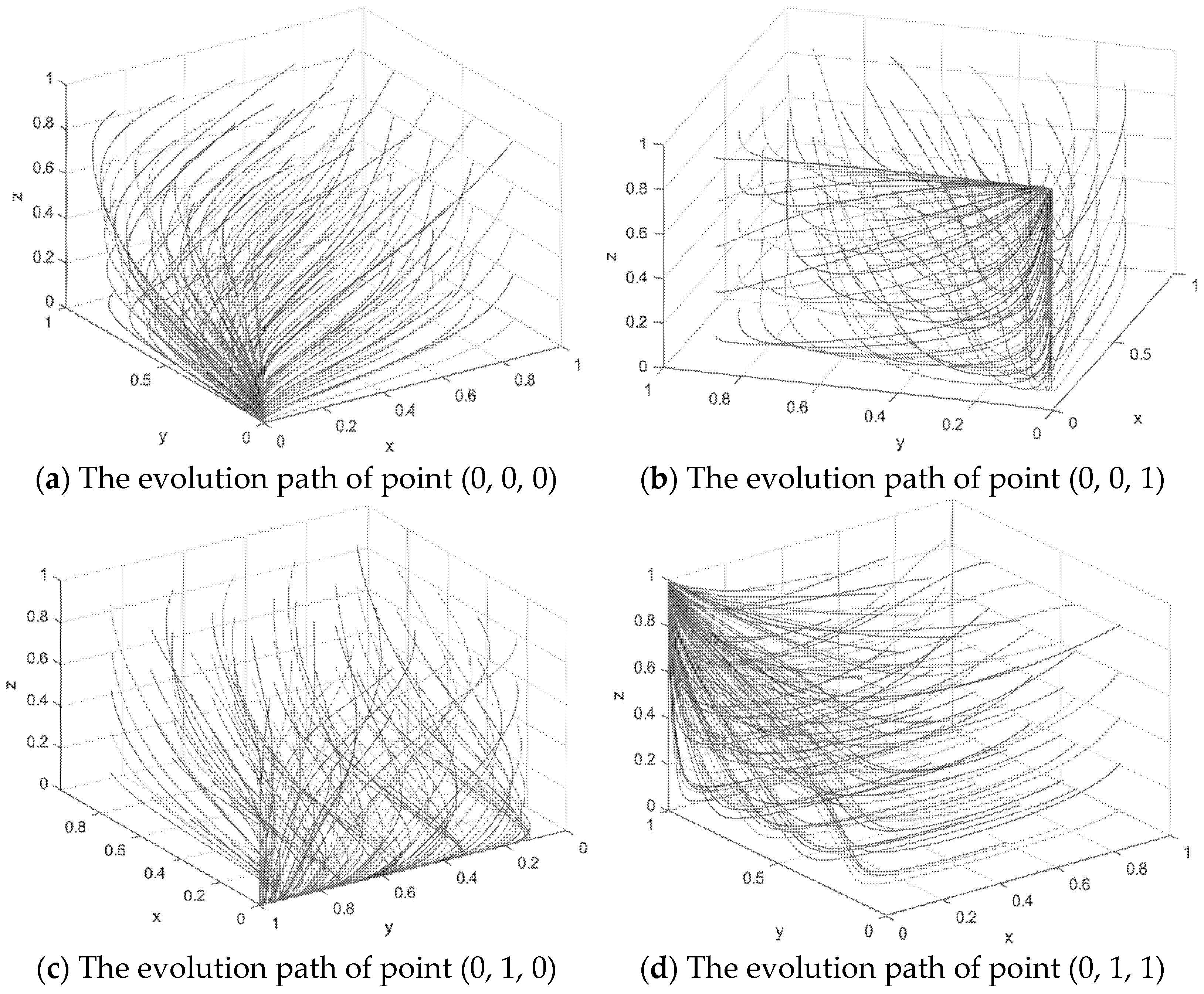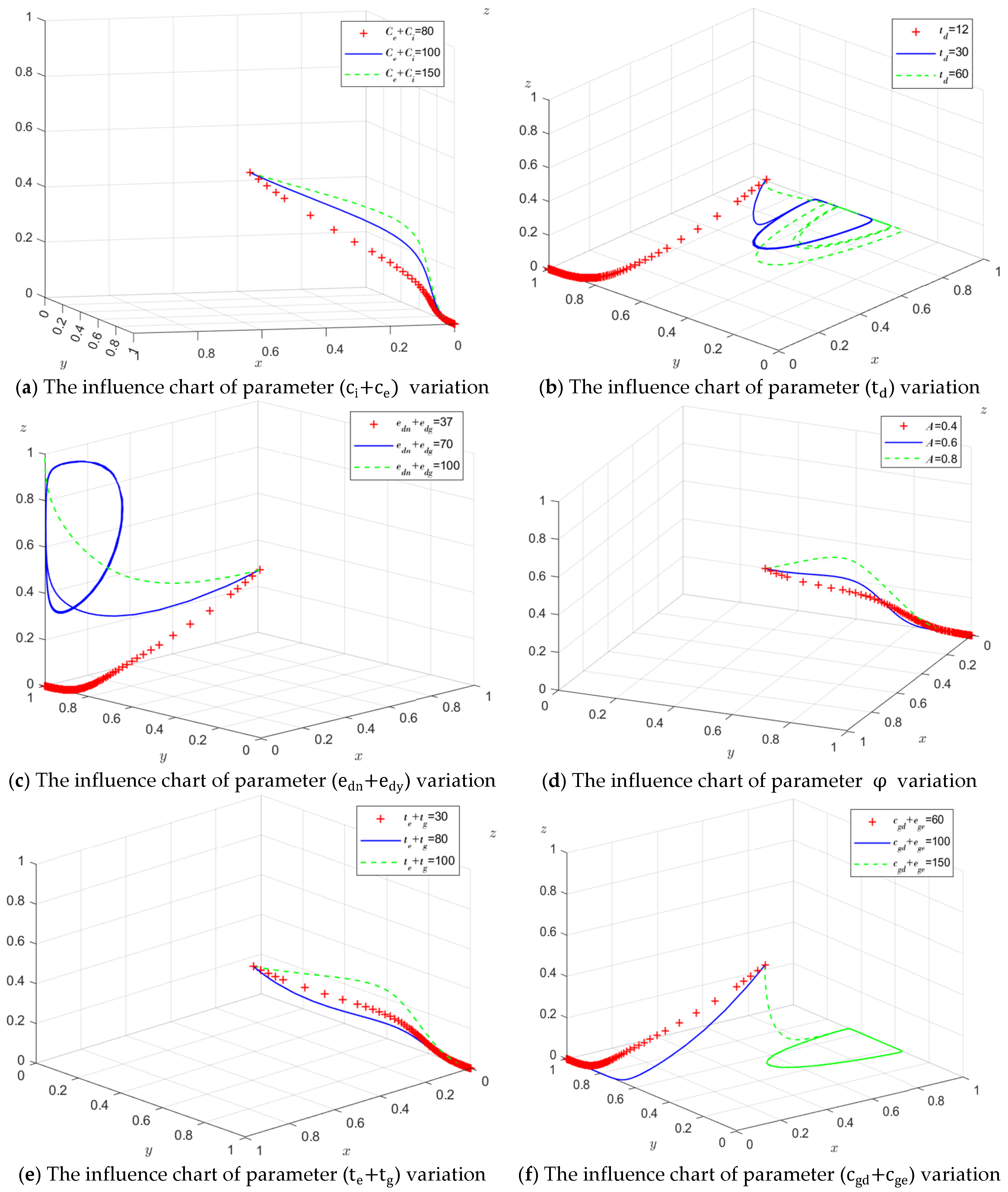2.2.1. Replicate the Construction of Dynamic Equations
Based on the revenue matrix in
Table 2, the expected revenue of clean production for heavily polluting enterprises is
, as shown in Formula (1) [
26].
The expected return for heavily polluting enterprises choosing non-clean production is
, as shown in Formula (2) [
26].
The average expected revenue of heavily polluting enterprises is
, as shown in Formula (3) [
26].
The replication dynamic equation (the replication dynamic equation is actually a dynamic differential equation that describes the frequency of a particular strategy adopted by a species in a population [
27] is as shown in Equation (4).
The expected revenue from the supervision of the environmental information regulatory department in accordance with the law is
, as shown in Formula (5) [
26].
The expected returns from illegal supervision by environmental information regulatory authorities are
, as shown in Formula (6) [
26].
The expected revenue of the environmental information regulatory department is
, as shown in Formula (7) [
26].
The replication dynamic equation of the policy selection of the environmental information disclosure regulatory authority is shown in Equation (8) [
27].
The expected return under strict government regulation is
, as shown in Formula (9) [
26].
The expected benefit of the government’s lenient regulation is
, as shown in Formula (10) [
26].
The expected revenue of the government is
, as shown in Formula (11) [
26].
The replication dynamic equation for government policy selection is shown in Equation (12) [
27].
2.2.2. Strategy Stability Analysis
According to the stability theorem of the dynamic equation of replication, for a single game player to be in a stable state, two conditions must be met. (1) Copy the dynamic equation to 0. (2) Copy the first derivative of the dynamic equation to be less than 0. The stability analysis of the three game players is shown in
Table 3.
In order to analyze the equilibrium conditions for a government subject to achieve a stable strategy from the perspective of a single game subject, the following analysis is conducted. Let find the stability of the strategies chosen by heavily polluting enterprises. Since the positive and negative values of are uncertain, the following discussion is held:
When , suppose , the following was true:
When ′, then , and thus all are in an evolutionary steady state, that is, the ratio does not change over time regardless of the initial ratio of “cleaner production” and “non-cleaner production” chosen by heavy polluting enterprises.
When , letting , we can obtain two possible evolutionary stability points as .
When , is the evolutionary and stable strategy of heavy polluting enterprises.
When
,
is the evolutionary and stable strategy of heavy polluting enterprises. To present the above conclusion more intuitively, this paper draws the strategy evolution trend chart of heavily polluting enterprises as shown in
Figure 2.
To analyze the equilibrium conditions required for the government to implement a stability strategy from the perspective of a single game player, we conduct the following research. Let F(y) = 0 to determine the stability of the selected strategy for environmental information supervision. Due to the uncertainty of the positive and negative values of , the following discussion is carried out:
When , suppose , the following was true:
When ′ , it means all y values remain in evolutionary stability.
When , letting , we can obtain two possible evolutionary stability points as .
When , is the evolution and stability strategy of the environmental information disclosure regulatory authorities.
When
,
is the evolution and stability strategy of the environmental information disclosure regulatory authorities. To present the above conclusion more intuitively, this paper draws the strategy evolution trend chart of environmental information regulatory authorities as shown in
Figure 3.
To analyze the equilibrium conditions required for the government to implement a stability strategy from the perspective of a single game player, we conduct the following research. Let F(z)=0 to determine the stability of the strategy chosen by the government. Due to the uncertainty of the positive and negative values of , the following discussion is carried out:
When =0, suppose , the following was true:
When x = x ߰, F(z) = 0, so all x are in an evolutionarily stable state
When ’, letting , two possible evolutionary stability points can be obtained as .
When , is the evolutionary and stable strategy of heavy polluting enterprises.
When
,
is the evolutionary and stable strategy of heavy polluting enterprises. To present the above conclusion more intuitively, this paper draws a government strategy evolution trend chart as shown in
Figure 4.
2.2.3. Stability Analysis of Equilibrium Points
Construct a replication dynamic system according to Equations (4), (9) and (12),
This allows
to obtain that there are 8 pure strategic Nash equilibrium points in the game process of heavy polluting enterprises, environmental information disclosure regulatory authorities and governments, namely (0,0,0), (0,0,1), (0,1,0), (1,0,0), (1,1,0), (1,0,1), (0,1,1), (1,1,1). Therefore, this section will draw on existing studies to solve the eigenvalues by constructing the Jacobian matrix to judge the asymptotic stability of the equilibrium point. The Jacobian matrix looks like this:
According to Lyapunov’s first method, when the eigenvalues are negative, the equilibrium point is the stable point; when the eigenvalues are positive, the equilibrium point is the unstable point; when the eigenvalue is positive and negative, it is the saddle point.
Table 4 presents the stability analysis of eight equilibrium points.
According to the analysis of the asymptotic stability conditions of the equilibrium point in
Table 3, it can be seen that (1, 0, 0), (1, 1, 0), (1, 0, 1), (1, 0, 1) and (1, 1, 1) have positive eigenvalues, so it cannot be an evolutionary stability strategy, and four evolutionary stability points and their conditions are obtained, namely (0, 0, 0), (0, 0, 1), (0, 1, 0), (0, 1, 0), and (0, 1, 1). The stability of these four equilibrium points can be discussed in the following four situations:
Scenario 1: If and , only the eigenvalues corresponding to the equilibrium point (0, 0, 0) are negative, so (0, 0, 0) is the evolutionary stability point of the system, and its corresponding evolutionary stability strategy is (non-cleaner production, non-legal supervision, loose supervision). When the environmental information disclosure regulatory department conducts inefficient supervision and the fine imposed by heavy polluting enterprises for failing to disclose environmental information in accordance with regulations is small, and the benefits obtained by the environmental information disclosure regulatory department are less than their regulatory costs, then the environmental information disclosure regulatory department has no motivation to supervise according to law, and will adopt the strategy of non-legal supervision. When the government collects fines less than its cost of verifying enterprises, the government will choose the strategy of loose regulation; when the government is loose supervision and the environmental supervision department is not supervised in accordance with the law, the binding force on the enterprise is reduced, and the enterprise will not be afraid of the penalty received during non-cleaner production, and the enterprise will choose the strategy of non-cleaner production.
Scenario 2: When ,,, only the eigenvalues corresponding to the equilibrium point (0, 0, 1) are negative, so (0, 0, 1) is the evolutionary stability point of the system, and its corresponding evolutionary stability strategy is (non-cleaner production, non-legal supervision, strict supervision). When the fines imposed on the polluted production of heavy polluting enterprises are verified and the environmental protection tax (pollutant discharge fee) paid by the polluted production of the enterprise is small, the subsidy for the environmental protection
If the production of the enterprise is verified, and the cost of upgrading the technology and equipment of the enterprise’s environmental protection production is higher than the cost of information disclosure by the enterprise according to regulations, then the heavy polluting enterprise will choose the strategy of non-cleaner production. When the income obtained by the regulatory authorities when supervising in accordance with the law and the losses suffered by the regulatory authorities when the regulatory authorities do not supervise in accordance with the law are lower than the supervision costs of the environmental information disclosure regulatory authorities, the environmental regulatory authorities will choose non-legal supervision; When heavy polluting enterprises are not cleaner production and environmental supervision departments are not supervised in accordance with the law, it will not only cause serious environmental pollution, but also seriously damage the general environment of local environmental governance, which is not conducive to the development of local environmental governance, so the local government will tend to increase the fines imposed on enterprises for verifying polluted production and the environmental protection tax (pollutant discharge fee) paid by enterprises for verifying polluted production, so as to promote enterprises to change to cleaner production. At this time the government will choose a stable strategy of strict supervision.
Scenario 3: When ,, only the eigenvalues corresponding to the equilibrium point (0, 1, 0) are negative, so (0, 1, 0) is the evolutionary stability point of the system, and its corresponding evolutionary stability strategy is (non-cleaner production, supervision according to law, loose supervision). At this time, environmental protection subsidies failed to promote the cleaner production of heavy polluting enterprises, but the local government’s rating measures and reward and punishment system for environmental regulatory authorities effectively regulated the behavior of environmental regulatory departments, enabling environmental regulatory authorities to supervise in accordance with the law, thus ensuring that the non-cleaner production of heavy polluting enterprises can be restrained under legal supervision.
Scenario 4: When ,, only the eigenvalues corresponding to the equilibrium point (0, 1, 1) are negative, so (0, 1, 1) is the evolutionary stability point of the system, and its corresponding evolutionary stability strategy is (non-cleaner production, supervision according to law, strict supervision). When the fines and negative impact of pollution on non-clean production of heavy polluting enterprises are low, and the cost of upgrading technology and equipment for environmental protection production is higher than the cost of information disclosure by enterprises in accordance with regulations, then heavy polluting enterprises will choose the strategy of non-clean production. However, at this time, the government’s strict supervision of the environmental regulatory authorities ensures that the regulatory authorities supervise heavy polluting enterprises in accordance with the law. Further restraint on heavy polluting enterprises.

